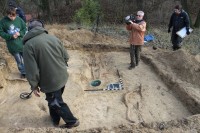 Refusing to let English moles get all the glory, a German badger has unearthed a 12th-century burial ground on a farm outside Stolpe in Brandenburg, Germany. the sculptors who live on the farm, Lars Wilhelm and his wife Hendrikje Ring, had noticed the badger digging his sett (a badger’s den) over the course of five years. They had an idea that they might install some of their sculptures in the sett for an exhibition, so they observed the badger’s progress closely.
Refusing to let English moles get all the glory, a German badger has unearthed a 12th-century burial ground on a farm outside Stolpe in Brandenburg, Germany. the sculptors who live on the farm, Lars Wilhelm and his wife Hendrikje Ring, had noticed the badger digging his sett (a badger’s den) over the course of five years. They had an idea that they might install some of their sculptures in the sett for an exhibition, so they observed the badger’s progress closely.
Last autumn, they saw the animal had turned up what appeared to be a human pelvic bone. Excavations by archaeologists in the 1960s had discovered an ancient graveyard on the other side of the road, so Lars and Hendrikje thought the badger might have turned up something similar. To see what else was inside that sett, they placed a camera into one of the openings and snapped photographs by remote control. They found jewelry that they were able to recover and then promptly called the authorities to report their finds.
The badger, his work now done, left the sett to the biped professionals. The archaeological excavation ultimately unearthed eight graves from the first half of the 12th century. Two of the graves were particularly notable because they held the remains of Slavic chieftains.
The skeletons in the two lords’ graves had bronze bowls at their feet. “That identified them as belonging to the social elite, they had the bowls to wash their hands before dining because they knew that was the refined thing to do,” said Kersting.
The objects found included an arrow head and a belt with a bronze, omega-shaped buckle with snake’s heads at each end.
One of the two skeletons was particularly well preserved and had evidently been a warrior. His body showed multiple sword and lance wounds and a healed fracture suggested he had fallen off his horse at some point, said Kersting.
The snake head buckle seem to be of Scandinavian manufacture, which underscores the warrior’s high status and wealth. Initial examination could not pinpoint the cause of his death. He was about 40 years old when he died, and he certainly was hardy, having taken several sword blows to the head that had healed before whatever killed him killed him. He was buried with a double-edged sword three feet long by his side, a testament to his battle-scarred existence.
The second of the two chieftains was missing his sword. Archaeologists believe his grave was looted, perhaps during the turbulence around the time of his burial. In the early 12th century, the Stolpe area was the site of constant conflict between the pagan Slavs who had lived there for centuries but whose power was on the wane, and the Christian Franks and Poles advancing from the west and east respectively. The people buried in this graveyard were among the last pre-Christian peoples in Germany. By the 12th century, east Brandenburg, central Germany, Pomerania and all of what is today Poland were fully Christianized.
Next to the second chieftain was the grave a woman, possibly his wife, who was found with a coin in her mouth to pay the ferryman for her passage over the river Styx to the underworld, another important indication that the deceased still worshiped the old Slavic deities.
The badger made the archaeologists very happy. These days they usually only get the chance to excavate sites slated for construction, and their work is bounded by the construction schedule. The badger’s digging gave them a rare opportunity to excavated an undeveloped site on a farm and they made an apposite rare find in a 12th century pagan burial ground. Nothing like it has been found in Brandenburg before.
The artifacts are currently being conserved. They will go on display in September at the State Archaeological Museum in the town of Brandenburg an der Havel.